- Accueil
- Pages cachées
- 22 DECEMBRE 2023 NEWS
22 DECEMBRE 2023 NEWS
INSTITUT SUPERIEUR D'ANTHROPOLOGIE
INSTITUT OF ANTHROPOLOGY
COURS ONLINE – COURS A DISTANCE
INSCRIPTIONS OUVERTES
REGISTER NOW
JORDANIE –  Petra - Petra was the capital of a powerful trading empire two thousand years ago. It was established by the Nabateans, a people native to the land who specialized in trade and served as the region’s political, cultural, and economic hub for many years. Petra is an ancient city in Jordan renowned for its remarkable rock-cut architecture. Established by the Nabateans around the 4th century BC, it later came under the control of the Roman Empire. The ancient capital city has a rich history that dates back thousands of years. Archaeologists have previously found a number of documents in this rich history that provide valuable insight into the lives of the city’s prehistoric residents. The discovery was made in 1961 by a team of archaeologists working in the area. The documents, like the Dead Sea Scrolls, had been forgotten in a cave for around 2,000 years. They were featured in the Smithsonian Channel documentary Sacred Sites: Petra, where the narrator stated, “They reveal astonishing information about the life of a Nabatean woman named Abi-adan, who lived in the first century AD.”This woman owned a large orchard of date palms at Maoza near the Dead Sea, indicating that women in ancient Petra could generate significant capital. The documents are now in the possession of the Israel Antiquities Authority, and Professor Hannah Cotton-Paltiel of the Hebrew University of Jerusalem is an expert on them. “Abi-adan is a Nabatean woman and the two documents are interesting because she’s selling the same orchard to one person and then to another,” she explained. Archelaus, a Nabatean strategos, more or less a provincial governor, bought the first orchard Abi-adan, and the month after, she sold another to a man called Shim‘on. The documents not only demonstrate her literacy but also her position in society, as her lands bordered those of the Nabatean king. Prof Cotton-Paltiel explained: “These are mainly legal documents. This is not a diary of a woman. But, all the time I feel that behind the documents dictated to scribes, there are women who know what they want. “The sense you get out of the documents is that she was completely independent.” Professor John Healey, from the University of Manchester, has studied the documents and the way in which society worked in Petra, and noted how women had “agency in this period”.The set of documents revealed an unprecedented amount of information about individuals who once called Petra home.
Petra - Petra was the capital of a powerful trading empire two thousand years ago. It was established by the Nabateans, a people native to the land who specialized in trade and served as the region’s political, cultural, and economic hub for many years. Petra is an ancient city in Jordan renowned for its remarkable rock-cut architecture. Established by the Nabateans around the 4th century BC, it later came under the control of the Roman Empire. The ancient capital city has a rich history that dates back thousands of years. Archaeologists have previously found a number of documents in this rich history that provide valuable insight into the lives of the city’s prehistoric residents. The discovery was made in 1961 by a team of archaeologists working in the area. The documents, like the Dead Sea Scrolls, had been forgotten in a cave for around 2,000 years. They were featured in the Smithsonian Channel documentary Sacred Sites: Petra, where the narrator stated, “They reveal astonishing information about the life of a Nabatean woman named Abi-adan, who lived in the first century AD.”This woman owned a large orchard of date palms at Maoza near the Dead Sea, indicating that women in ancient Petra could generate significant capital. The documents are now in the possession of the Israel Antiquities Authority, and Professor Hannah Cotton-Paltiel of the Hebrew University of Jerusalem is an expert on them. “Abi-adan is a Nabatean woman and the two documents are interesting because she’s selling the same orchard to one person and then to another,” she explained. Archelaus, a Nabatean strategos, more or less a provincial governor, bought the first orchard Abi-adan, and the month after, she sold another to a man called Shim‘on. The documents not only demonstrate her literacy but also her position in society, as her lands bordered those of the Nabatean king. Prof Cotton-Paltiel explained: “These are mainly legal documents. This is not a diary of a woman. But, all the time I feel that behind the documents dictated to scribes, there are women who know what they want. “The sense you get out of the documents is that she was completely independent.” Professor John Healey, from the University of Manchester, has studied the documents and the way in which society worked in Petra, and noted how women had “agency in this period”.The set of documents revealed an unprecedented amount of information about individuals who once called Petra home.
UKRAINE - 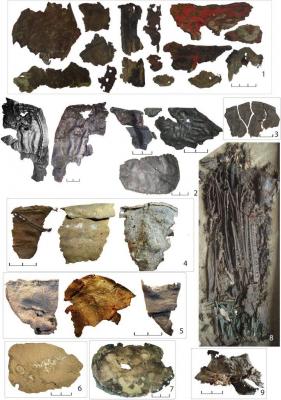
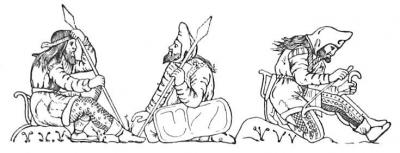 -- The ancient Scythians’ history as fearsome warriors dates back more than 2,000 years, and now research from a multi-institutional team of anthropologists confirms that they are pitiless warriors. Researchers have discovered that Scythian warriors carried their arrows in leather quivers made from the skin of their defeated enemies. In their project, reported on the open-access site PLOS ONE, the researchers tested an account by the Greek historian Herodotus regarding certain behaviors of ancient Scythian warriors. The authors of a new study have finally provided scientific validation for these grizzly claims. The researchers were able to identify the species from which each piece of skin was taken by using a series of techniques to analyze the proteins in 45 leather samples recovered from 14 different Scythian sites in southern Ukraine. The researchers analyzed 45 leather samples collected from 14 Scythian dig sites using a variety of paleoproteomics techniques. They were able to determine the origin of all but two of them, which were made from horse, cattle, goat, or sheep skin. The other two had a human source to back up what Herodotus said. However, the researchers discovered pieces of leather derived from human skin in two of the quivers they examined. Further examination of the two human skin leather samples revealed that they were only used on the top parts of the quivers; the rest of the quivers were made of animal leather. It is important to note that the Scythians were not the first to use human skin for leather. Human skin has been used for a variety of purposes throughout history, including bookbinding and the creation of macabre artifacts. The discovery of human skin leather among the Scythians, on the other hand, provides valuable insights into their cultural practices. According to one theory, the use of human skin in leather production may have been linked to religious or ritualistic beliefs. The Scythians were well-known for their intricate funerary practices, which frequently included elaborate burial rituals and the inclusion of valuable items in tombs. Human skin leather may have been used to honor or commemorate the deceased. Another possibility is that the use of human skin leather was a means of conquering or dominating enemies. The Scythians were skilled warriors who frequently clashed with neighboring tribes. The creation of leather items from defeated enemies’ skins could have been a way for them to assert their power and intimidate their opponents. The researchers propose that their results not only validate legends about the prehistoric Scythian fighters but also demonstrate that the fighters were making their quivers from easily accessible materials.
-- The ancient Scythians’ history as fearsome warriors dates back more than 2,000 years, and now research from a multi-institutional team of anthropologists confirms that they are pitiless warriors. Researchers have discovered that Scythian warriors carried their arrows in leather quivers made from the skin of their defeated enemies. In their project, reported on the open-access site PLOS ONE, the researchers tested an account by the Greek historian Herodotus regarding certain behaviors of ancient Scythian warriors. The authors of a new study have finally provided scientific validation for these grizzly claims. The researchers were able to identify the species from which each piece of skin was taken by using a series of techniques to analyze the proteins in 45 leather samples recovered from 14 different Scythian sites in southern Ukraine. The researchers analyzed 45 leather samples collected from 14 Scythian dig sites using a variety of paleoproteomics techniques. They were able to determine the origin of all but two of them, which were made from horse, cattle, goat, or sheep skin. The other two had a human source to back up what Herodotus said. However, the researchers discovered pieces of leather derived from human skin in two of the quivers they examined. Further examination of the two human skin leather samples revealed that they were only used on the top parts of the quivers; the rest of the quivers were made of animal leather. It is important to note that the Scythians were not the first to use human skin for leather. Human skin has been used for a variety of purposes throughout history, including bookbinding and the creation of macabre artifacts. The discovery of human skin leather among the Scythians, on the other hand, provides valuable insights into their cultural practices. According to one theory, the use of human skin in leather production may have been linked to religious or ritualistic beliefs. The Scythians were well-known for their intricate funerary practices, which frequently included elaborate burial rituals and the inclusion of valuable items in tombs. Human skin leather may have been used to honor or commemorate the deceased. Another possibility is that the use of human skin leather was a means of conquering or dominating enemies. The Scythians were skilled warriors who frequently clashed with neighboring tribes. The creation of leather items from defeated enemies’ skins could have been a way for them to assert their power and intimidate their opponents. The researchers propose that their results not only validate legends about the prehistoric Scythian fighters but also demonstrate that the fighters were making their quivers from easily accessible materials.
KAZAKHSTAN – 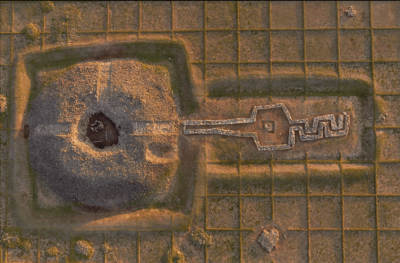
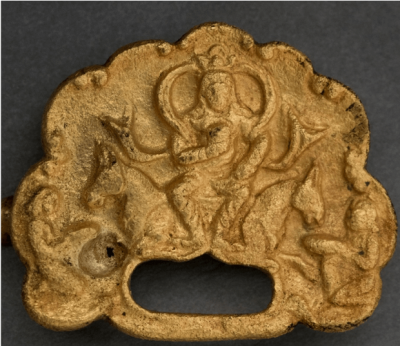 Eleke Sazy - A social complex (Külliye) and new artifacts from the Western Gokturk period were discovered in Kazakhstan. Among these items, a belt buckle depicting the face of a Gokturk Khagan was found for the first time in history. Eleke Sazy is a valley in the Tarbagatay district of Kazakhstan’s Eastern Kazakhstan region. As a result of the archaeological surveys conducted between 2016 and 2018, more than 300 kurgans dating to the wide period of time from 9th century B.C. to 7th century A.D. were identified. Primarily, the discovery of the memorial cult-complex of the Western Turkic Khaganate attracts particular attention. Eleke Sazy is a significant discovery from the perspective of pre-Islamic Turkic Art and Archaeology because it is the first and only memorial cult complex of Turkic Khaganate have determined outside of Mongolia until present. During the excavations in 2021, the personal belongings of Tegin -an ancient Turkish title with the original meaning of “prince”-, who belonged to the Göktürk lineage and was assigned to manage the On-Ok province on behalf of the Turkish Khagan in Suyab, were found in the kurgan area in the Eleke Sazy Khagan complex. For the first time in history, a depiction of a Göktürk Khagan was found among these items. The similarity of the complex in structure and form shows that it may have been built during the 2nd Gokturk State. “Of course, this center was a complex built in memory of one of the Western Gokturk Khagans. Later, a large mausoleum was built here. Of course, this complex is of great importance for the Turkish world in terms of its architectural style, burial ceremonies, findings, and religious belief cult,” said Prof. Dr. Zainolla Samashev. Stating that the findings found in the grave area were the personal belongings of the representatives who attended the Khagan’s burial ceremony, Professor Samashev said, “When we look at the Göktürk burial ceremonies, it was a duty to put personal belongings and weapons in the grave of the deceased. Among the recovered objects was a belt buckle made of gold plates.” made the statement. On this buckle, there is a depiction of the Göktürk kagan sitting on his throne, holding a crown on his head and an oath goblet in his hand. Prof. Dr. Samashev emphasized that the discovered ornamentation is a literary heritage attributed to Turkic peoples, highlighting the significance of the depiction in this regard. The two decorated gold plates, identified as belt buckles, depict a Khagan seated on his throne with attendants serving him. Wearing a golden belt was a sign of dominance in the ancient Turkish states. Dr. Serhan Çınar says that in the identified images, the Göktürk kagan has long hair and is about 30-35 years old: “In the composition of the ornament, it is seen that the Khagan is depicted in the traditional Turkish type of sitting cross-legged and has a crown resembling a three-cornered halo on his head. The images in the buckle ornament also clearly show the throne on which the Khagan is seated and the bridesmaids serving him. The flowers surrounding the throne are thought to be lotus flowers, which are often used in Buddhist art.” Prof. Dr. Zaimollo Samashev states that the belt buckle dates back to the end of the 8th century. Since there is information about who the Khagans were at the end of the 8th century, the owner of the belt likely was one of these Khagans. A second possibility is that the complex where the golden belt buckle was found belonged to a Tudun who was affiliated with the Khagan of Ötüken or Suyab, the center of the Western Göktürk Khaganate and that he gave it as a gift to the ruler’s son as a sign of dominance. As a result of the archaeological studies and excavations conducted, it has been possible to obtain important information regarding features of the architectural plan of the memorial cult complex of Turkic Khaganate. The memorial cult complex consists of temple, ceremonial pathway and additional structures located in the eastern part. Furthermore, the statue with the all characteristics of a Turkic Khagan made of granite from the same complex is also of great importance.
Eleke Sazy - A social complex (Külliye) and new artifacts from the Western Gokturk period were discovered in Kazakhstan. Among these items, a belt buckle depicting the face of a Gokturk Khagan was found for the first time in history. Eleke Sazy is a valley in the Tarbagatay district of Kazakhstan’s Eastern Kazakhstan region. As a result of the archaeological surveys conducted between 2016 and 2018, more than 300 kurgans dating to the wide period of time from 9th century B.C. to 7th century A.D. were identified. Primarily, the discovery of the memorial cult-complex of the Western Turkic Khaganate attracts particular attention. Eleke Sazy is a significant discovery from the perspective of pre-Islamic Turkic Art and Archaeology because it is the first and only memorial cult complex of Turkic Khaganate have determined outside of Mongolia until present. During the excavations in 2021, the personal belongings of Tegin -an ancient Turkish title with the original meaning of “prince”-, who belonged to the Göktürk lineage and was assigned to manage the On-Ok province on behalf of the Turkish Khagan in Suyab, were found in the kurgan area in the Eleke Sazy Khagan complex. For the first time in history, a depiction of a Göktürk Khagan was found among these items. The similarity of the complex in structure and form shows that it may have been built during the 2nd Gokturk State. “Of course, this center was a complex built in memory of one of the Western Gokturk Khagans. Later, a large mausoleum was built here. Of course, this complex is of great importance for the Turkish world in terms of its architectural style, burial ceremonies, findings, and religious belief cult,” said Prof. Dr. Zainolla Samashev. Stating that the findings found in the grave area were the personal belongings of the representatives who attended the Khagan’s burial ceremony, Professor Samashev said, “When we look at the Göktürk burial ceremonies, it was a duty to put personal belongings and weapons in the grave of the deceased. Among the recovered objects was a belt buckle made of gold plates.” made the statement. On this buckle, there is a depiction of the Göktürk kagan sitting on his throne, holding a crown on his head and an oath goblet in his hand. Prof. Dr. Samashev emphasized that the discovered ornamentation is a literary heritage attributed to Turkic peoples, highlighting the significance of the depiction in this regard. The two decorated gold plates, identified as belt buckles, depict a Khagan seated on his throne with attendants serving him. Wearing a golden belt was a sign of dominance in the ancient Turkish states. Dr. Serhan Çınar says that in the identified images, the Göktürk kagan has long hair and is about 30-35 years old: “In the composition of the ornament, it is seen that the Khagan is depicted in the traditional Turkish type of sitting cross-legged and has a crown resembling a three-cornered halo on his head. The images in the buckle ornament also clearly show the throne on which the Khagan is seated and the bridesmaids serving him. The flowers surrounding the throne are thought to be lotus flowers, which are often used in Buddhist art.” Prof. Dr. Zaimollo Samashev states that the belt buckle dates back to the end of the 8th century. Since there is information about who the Khagans were at the end of the 8th century, the owner of the belt likely was one of these Khagans. A second possibility is that the complex where the golden belt buckle was found belonged to a Tudun who was affiliated with the Khagan of Ötüken or Suyab, the center of the Western Göktürk Khaganate and that he gave it as a gift to the ruler’s son as a sign of dominance. As a result of the archaeological studies and excavations conducted, it has been possible to obtain important information regarding features of the architectural plan of the memorial cult complex of Turkic Khaganate. The memorial cult complex consists of temple, ceremonial pathway and additional structures located in the eastern part. Furthermore, the statue with the all characteristics of a Turkic Khagan made of granite from the same complex is also of great importance.
PEROU – 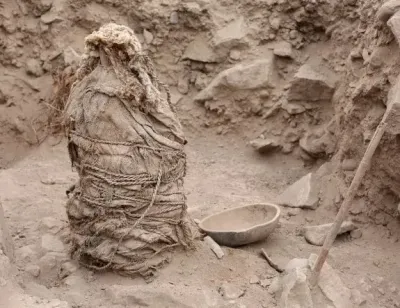 Pachacámac - Archaeologists in Peru have revealed the discovery of the burial grounds of at least 73 individuals dating back approximately 1,000 years, predating the Inca’s dominance in western South America by a few hundred years. Each of these were wrapped in fabric, some of which exhibited vibrant colors, and secured with rope. The male and female remains were accompanied by wooden and ceramic masks, commonly referred to as “false heads,” as reported by Krzysztof Makowski, the head of archaeological research at the site and an archaeologist at the Pontifical Catholic University of Peru. The graves, situated near Lima at the Pachacámac archaeological site, are attributed to the Wari culture and date between 800 and 1100 AD, aligning with the Wari Empire’s territorial expansion in the region. Alongside the burials, two wooden structures were unearthed near the cemetery within the remains of an adjacent settlement. These staffs, discovered amid a deposit of ‘thorny oyster’ shells imported from present-day Ecuador, north of the Wari Empire, feature carved iconography indicating potential connections between the people at Pachacámac and those in the Tiwanaku kingdom to the south of the Wari Empire, spanning parts of Peru, Bolivia, and Chile. Each staff bears carvings depicting a dignitary adorned with headgear resembling that worn in the Tiwanaku kingdom. The ongoing excavations at Pachacámac, coupled with the analysis of recovered remains, promise to offer further insights into the ancient interactions and influences between these civilizations.
Pachacámac - Archaeologists in Peru have revealed the discovery of the burial grounds of at least 73 individuals dating back approximately 1,000 years, predating the Inca’s dominance in western South America by a few hundred years. Each of these were wrapped in fabric, some of which exhibited vibrant colors, and secured with rope. The male and female remains were accompanied by wooden and ceramic masks, commonly referred to as “false heads,” as reported by Krzysztof Makowski, the head of archaeological research at the site and an archaeologist at the Pontifical Catholic University of Peru. The graves, situated near Lima at the Pachacámac archaeological site, are attributed to the Wari culture and date between 800 and 1100 AD, aligning with the Wari Empire’s territorial expansion in the region. Alongside the burials, two wooden structures were unearthed near the cemetery within the remains of an adjacent settlement. These staffs, discovered amid a deposit of ‘thorny oyster’ shells imported from present-day Ecuador, north of the Wari Empire, feature carved iconography indicating potential connections between the people at Pachacámac and those in the Tiwanaku kingdom to the south of the Wari Empire, spanning parts of Peru, Bolivia, and Chile. Each staff bears carvings depicting a dignitary adorned with headgear resembling that worn in the Tiwanaku kingdom. The ongoing excavations at Pachacámac, coupled with the analysis of recovered remains, promise to offer further insights into the ancient interactions and influences between these civilizations.
Pre-Inca mummies discovered in Peru show connection to other ancient civilizations - CuencaHighLife
ANGLETERRE – 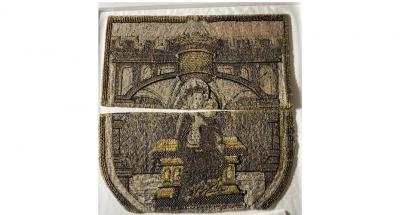 - Rich fabrics and fine embroidery seized from hundreds of churches closed by Henry VIII during the English Reformation were saved and repurposed through a remarkable recycling network that reached across all strata of 16th century society. New research has uncovered how medieval church vestments, including some of the most luxurious Italian-imported fabrics, made their way into the homes and living spaces of Tudor society via a network which included government officials, merchants, craftspeople and extended families. Officers from the Court of Augmentations, set up to manage the process of dissolving the monasteries and chantry chapels and to ensure that the Crown took most of their treasures, even kept a look-out for fine fabrics which they might like to keep for themselves. These are the preliminary findings of a project called Textile Transmissions, which is being conducted by the National Trust and the University of Exeter and centres upon a collection of fabrics held at Hardwick Hall in Derbyshire, belonging to Elizabeth Talbot, Countess of Shrewsbury (1527–1608). Best known as “Bess of Hardwick”, the Countess was renowned for her interior decoration of her mansion houses Chatsworth and Hardwick, where she invested lavishly in carpets, tapestries and embroideries. Her schemes have always been seen as the conspicuous consumption of the very latest fashions in art and design with the aim of positioning herself at the apex of Tudor society. But, the researchers say, the reality is more nuanced, and that these remarkable interiors were an expression of Bess’s own creative ingenuity, making modish new decorations from second-hand materials, continuing a tradition of recycling and upcycling which was age-old.“On first encounter, the embroidered textiles that survive today at Hardwick appear to carry the hallmarks of artwork from the end of the Tudor era, their subjects taken from Roman and Old Testament history, and their style copying the classicism of the European Renaissance,” said Emma Slocombe, Senior National Curator at the National Trust. “Yet seen in close-up, the appliqué hangings reveal a remarkable secret: each one is made from fabric and figures cut from textiles originally made for a quite different purpose. In fact, Bess’s textiles began life decades before she embarked on the decoration of her great houses as clergy vestments and altar cloths used in churches of all kinds before the Tudor Reformation. Bess’s bespoke decorations for her new homes were in fact old textiles recovered and recycled.” Professor James Clark, the lead researcher on the project, from Exeter’s Department of Archaeology and History, continues: “What can be seen so vividly at Hardwick, was part of an impulse to recover, conserve and recycle that was shared in Tudor households countrywide. Across the country, there was an excited scramble for bargains and cultural souvenirs put up for sale as part of the dismantling, dispersal and destruction of the interior decorations of hundreds of churches. Textiles were among the most popular and sought-after of all of these treasures, in part because of the quality of England’s church vestments – a combination of rare Italian fabrics and insular embroidery skill – but also because such fine, well-crafted pieces clearly had so many years’ use left in them.”
- Rich fabrics and fine embroidery seized from hundreds of churches closed by Henry VIII during the English Reformation were saved and repurposed through a remarkable recycling network that reached across all strata of 16th century society. New research has uncovered how medieval church vestments, including some of the most luxurious Italian-imported fabrics, made their way into the homes and living spaces of Tudor society via a network which included government officials, merchants, craftspeople and extended families. Officers from the Court of Augmentations, set up to manage the process of dissolving the monasteries and chantry chapels and to ensure that the Crown took most of their treasures, even kept a look-out for fine fabrics which they might like to keep for themselves. These are the preliminary findings of a project called Textile Transmissions, which is being conducted by the National Trust and the University of Exeter and centres upon a collection of fabrics held at Hardwick Hall in Derbyshire, belonging to Elizabeth Talbot, Countess of Shrewsbury (1527–1608). Best known as “Bess of Hardwick”, the Countess was renowned for her interior decoration of her mansion houses Chatsworth and Hardwick, where she invested lavishly in carpets, tapestries and embroideries. Her schemes have always been seen as the conspicuous consumption of the very latest fashions in art and design with the aim of positioning herself at the apex of Tudor society. But, the researchers say, the reality is more nuanced, and that these remarkable interiors were an expression of Bess’s own creative ingenuity, making modish new decorations from second-hand materials, continuing a tradition of recycling and upcycling which was age-old.“On first encounter, the embroidered textiles that survive today at Hardwick appear to carry the hallmarks of artwork from the end of the Tudor era, their subjects taken from Roman and Old Testament history, and their style copying the classicism of the European Renaissance,” said Emma Slocombe, Senior National Curator at the National Trust. “Yet seen in close-up, the appliqué hangings reveal a remarkable secret: each one is made from fabric and figures cut from textiles originally made for a quite different purpose. In fact, Bess’s textiles began life decades before she embarked on the decoration of her great houses as clergy vestments and altar cloths used in churches of all kinds before the Tudor Reformation. Bess’s bespoke decorations for her new homes were in fact old textiles recovered and recycled.” Professor James Clark, the lead researcher on the project, from Exeter’s Department of Archaeology and History, continues: “What can be seen so vividly at Hardwick, was part of an impulse to recover, conserve and recycle that was shared in Tudor households countrywide. Across the country, there was an excited scramble for bargains and cultural souvenirs put up for sale as part of the dismantling, dispersal and destruction of the interior decorations of hundreds of churches. Textiles were among the most popular and sought-after of all of these treasures, in part because of the quality of England’s church vestments – a combination of rare Italian fabrics and insular embroidery skill – but also because such fine, well-crafted pieces clearly had so many years’ use left in them.”
New research reveals the Tudors were avid recyclers - News (exeter.ac.uk)
PEROU – 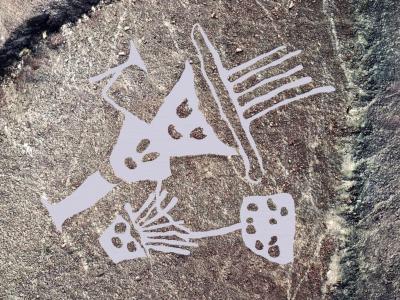
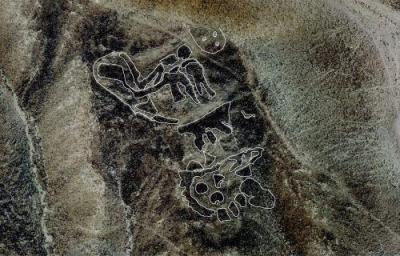 Ica - In Ica, a region south of Lima on the coast of Peru, 29 geoglyphs were found by an archaeologist from the San Luis Gonzaga National University (UNICA) and a team of 20 students. 29 years after UNESCO declared the famous Lines and Geoglyphs of Nasca and Palca as Cultural Heritage of Humanity (December 17, 1994), a new discovery with impressive figures in Ica highlights this region which houses this testimony of ancient Peruvian astronomical and religious expression. The discovery was made in the Ica region’s El Ingenio and Changuillo districts, which are part of the Nazca province. The geoglyphs date from between 300 BC and AD 100, which corresponds to the late Paracas and early Nasca periods, according to the researchers. Cats and anthropomorphic figures are depicted in these geoglyphs. They were discovered during a four-month research project that was approved by the Ministry of Culture. The study has identified 10 geoglyphs in the El Ingenio District that feature feline figures measuring up to 17 meters long by 12 meters tall, while in the Changuillo District, the team found 8 geoglyphs depicting feline figures measuring up to 37 meters long by 13 meters tall. The remaining geoglyphs discovered show anthropomorphic figures, ten of which were discovered in the El Ingenio District and one in the Changuillo District. Felines appear frequently in Paracas Culture, including ceramics and textiles. Some researchers believe they are associated with fertility and are a water deity. The Paracas culture was an ancient civilization that thrived on the southern coast of Peru, dating back to around 800 BCE to 100 BCE. They are renowned for their remarkable advancements in textile arts, particularly weaving, which produced intricately designed textiles with vibrant colors. The Paracas culture is divided into two phases: Paracas Cavernas and Paracas Necropolis. The latter is characterized by its elaborate burials and exceptional textiles. Their influence extended through trade networks, connecting them with other ancient cultures like the Chavín and Nazca civilizations. However, the decline of the Paracas culture occurred around 200 BCE, possibly due to environmental changes or conflicts within the society.
Ica - In Ica, a region south of Lima on the coast of Peru, 29 geoglyphs were found by an archaeologist from the San Luis Gonzaga National University (UNICA) and a team of 20 students. 29 years after UNESCO declared the famous Lines and Geoglyphs of Nasca and Palca as Cultural Heritage of Humanity (December 17, 1994), a new discovery with impressive figures in Ica highlights this region which houses this testimony of ancient Peruvian astronomical and religious expression. The discovery was made in the Ica region’s El Ingenio and Changuillo districts, which are part of the Nazca province. The geoglyphs date from between 300 BC and AD 100, which corresponds to the late Paracas and early Nasca periods, according to the researchers. Cats and anthropomorphic figures are depicted in these geoglyphs. They were discovered during a four-month research project that was approved by the Ministry of Culture. The study has identified 10 geoglyphs in the El Ingenio District that feature feline figures measuring up to 17 meters long by 12 meters tall, while in the Changuillo District, the team found 8 geoglyphs depicting feline figures measuring up to 37 meters long by 13 meters tall. The remaining geoglyphs discovered show anthropomorphic figures, ten of which were discovered in the El Ingenio District and one in the Changuillo District. Felines appear frequently in Paracas Culture, including ceramics and textiles. Some researchers believe they are associated with fertility and are a water deity. The Paracas culture was an ancient civilization that thrived on the southern coast of Peru, dating back to around 800 BCE to 100 BCE. They are renowned for their remarkable advancements in textile arts, particularly weaving, which produced intricately designed textiles with vibrant colors. The Paracas culture is divided into two phases: Paracas Cavernas and Paracas Necropolis. The latter is characterized by its elaborate burials and exceptional textiles. Their influence extended through trade networks, connecting them with other ancient cultures like the Chavín and Nazca civilizations. However, the decline of the Paracas culture occurred around 200 BCE, possibly due to environmental changes or conflicts within the society.
Feline and anthropomorphic 29 new geoglyphs discovered in Peru - Arkeonews
EGYPTE – 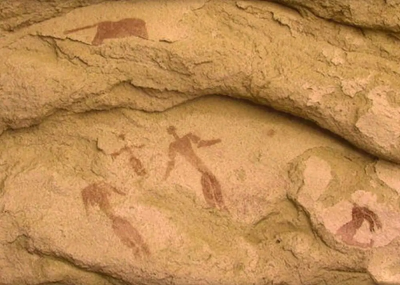 Sahara - 5,000-year-old rock art depicting the oldest nativity scene ever found has been found in Egypt’s Sahara Desert: A newborn between parents, two animals, and a star in the east. Reminiscent of the Bible’s account of Jesus’s birth, the prehistoric painting predates the biblical account by around 3,000 years. A team of Italian researchers found the painting inside a cavity, which has subsequently been dubbed the “Cave of the Parents,” in the Egyptian Sahara during field expeditions between the Gilf al-Kebir plateau and the Nile Valley. A newborn between parents, a star in the east, and two animals are depicted in the rock painting. According to Seeker.com, it was discovered on the ceiling of a small cavity in the Egyptian Sahara desert. Researchers believe it dates to the Neolithic or Stone Age. The rock painting, done in a reddish-brown ochre, has several notable features: a headless lion -One of Jesus’ titles is the Lion of Judah- also headless lions were mythical in the Neolithic or New Stone Age in that part of the world, a baboon or monkey, a star set in the east, and a baby who is slightly raised to the sky, a position that could have signified birth or pregnancy, Seeker reported.
Sahara - 5,000-year-old rock art depicting the oldest nativity scene ever found has been found in Egypt’s Sahara Desert: A newborn between parents, two animals, and a star in the east. Reminiscent of the Bible’s account of Jesus’s birth, the prehistoric painting predates the biblical account by around 3,000 years. A team of Italian researchers found the painting inside a cavity, which has subsequently been dubbed the “Cave of the Parents,” in the Egyptian Sahara during field expeditions between the Gilf al-Kebir plateau and the Nile Valley. A newborn between parents, a star in the east, and two animals are depicted in the rock painting. According to Seeker.com, it was discovered on the ceiling of a small cavity in the Egyptian Sahara desert. Researchers believe it dates to the Neolithic or Stone Age. The rock painting, done in a reddish-brown ochre, has several notable features: a headless lion -One of Jesus’ titles is the Lion of Judah- also headless lions were mythical in the Neolithic or New Stone Age in that part of the world, a baboon or monkey, a star set in the east, and a baby who is slightly raised to the sky, a position that could have signified birth or pregnancy, Seeker reported.
A cave painting found in Egyptian Sahara depicts a nativity scene 3,000 years before Jesus’ Birth - Arkeonews
CHINE - -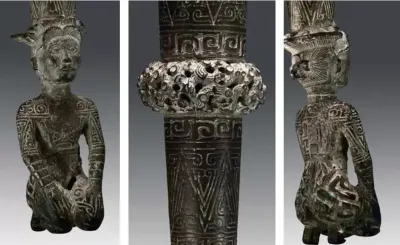 Chenwang - Rich archaeological findings spanning over 4,000 years from the Neolithic Hemudu culture to the Song Dynasty (960-1279) have been unearthed in a site in Ningbo, east China's Zhejiang Province, according to the Ningbo municipal research academy of cultural heritage management. This was reported by The Xinhua News Agency. The Chenwang site, which was first discovered in June 2022 in Ningbo's Fenghua District, is divided into two sections with respective areas of 3,400 square meters and 4,400 square meters. According to Ding Fengya, the person in charge of the excavation site, the excavation took place from February to August this year, revealing six historic layers, the earliest representing the late stage of the Hemudu culture. Most of the unearthed relics date back to the prehistoric period, and include earthen platforms, tombs, wooden cellar pits, and ash trenches from the fourth phase of Hemudu culture, as well as house remains, pottery fragments and stone tools from the Liangzhu culture. Patterned pottery fragments from the Warring States period (475-221 BC), house foundations and construction parts from the Han (202 BC-220 AD) and Six (222-589) dynasties, and porcelain from the Tang (618-907) and Song dynasties are among the other discoveries.
Chenwang - Rich archaeological findings spanning over 4,000 years from the Neolithic Hemudu culture to the Song Dynasty (960-1279) have been unearthed in a site in Ningbo, east China's Zhejiang Province, according to the Ningbo municipal research academy of cultural heritage management. This was reported by The Xinhua News Agency. The Chenwang site, which was first discovered in June 2022 in Ningbo's Fenghua District, is divided into two sections with respective areas of 3,400 square meters and 4,400 square meters. According to Ding Fengya, the person in charge of the excavation site, the excavation took place from February to August this year, revealing six historic layers, the earliest representing the late stage of the Hemudu culture. Most of the unearthed relics date back to the prehistoric period, and include earthen platforms, tombs, wooden cellar pits, and ash trenches from the fourth phase of Hemudu culture, as well as house remains, pottery fragments and stone tools from the Liangzhu culture. Patterned pottery fragments from the Warring States period (475-221 BC), house foundations and construction parts from the Han (202 BC-220 AD) and Six (222-589) dynasties, and porcelain from the Tang (618-907) and Song dynasties are among the other discoveries.
Relics spanning over 4,000 years unearthed in China's Zhejiang | Ukrainian news (ukranews.com)
ALLEMAGNE – 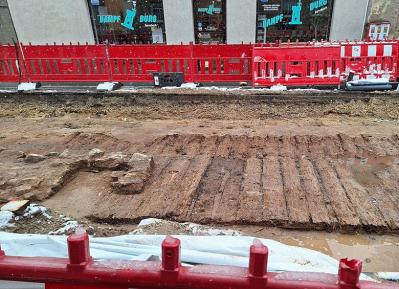 Fürth - During construction work in November 2023, road construction workers in Fürth came across an archaeological sensation: a centuries-old boardwalk under Würzburger Straße in the Burgfarrnbach district. This historic path, on which the Franks of the early modern period once drove their carts, is now being uncovered piece by piece and provides insights into the rich history of Middle Franconia, Germany. During road construction work in the Burgfarrnbach district of Fürth, the remains of a historic trade route from Nuremberg to Frankfurt came to light, reports the Bavarian State Office for monument preservation. Bit by bit, the archaeologists are now uncovering the heavy wooden planks that once fortified the centuries-old path and are hoping for further finds. It is common knowledge that a large number of European cities and settlement structures have a fascinating past. But archaeology frequently lacks access to historical remnants because of modern development. But sometimes opportunities present themselves; in this instance, for example, the archaeological findings were also the result of construction work. Underneath the present paving, workers renovating Würzburger Straße in the Fürth district of Burgfarrnbach discovered some unusual structures last November. This led to the current archaeological investigation, the findings of which are now being reported on by the Bavarian State Office for Monument Preservation (BLfD). The archaeologists discovered the hundreds of years old remains of a boardwalk, which is now being uncovered for meters further. The community chronicle from 1592 provides the first references to the Bohlenweg, which was once the town thoroughfare and represented an important long-distance route between Nuremberg and Frankfurt. It says that the residents were asked to maintain the path and, where necessary, repair it. Dendrochronological dating of pine planks recovered during the current excavations revealed that they were felled in 1773. In 1790, the people of Fürth were treated to a very special spectacle: on September 27th, a procession with noble carriages and horses paraded through Burgfarrnbach to ceremoniously accompany the valuable imperial jewels such as the imperial crown and the Holy Lance – the treasure of the German emperors and kings. By this time at the latest, the wooden plank road must have been developed into a paved road based on the Berlin model. With every plank uncovered, fascinating relics emerge, offering an insight into everyday life in past centuries. Buttons, horseshoes and even a silver coin from the early modern period have already been discovered. While experts continue to work on recovering a particularly well-preserved part of the path and preserving it for research and presentation purposes, the exposure of the boardwalk will add an important chapter to the history of Middle Franconia.
Fürth - During construction work in November 2023, road construction workers in Fürth came across an archaeological sensation: a centuries-old boardwalk under Würzburger Straße in the Burgfarrnbach district. This historic path, on which the Franks of the early modern period once drove their carts, is now being uncovered piece by piece and provides insights into the rich history of Middle Franconia, Germany. During road construction work in the Burgfarrnbach district of Fürth, the remains of a historic trade route from Nuremberg to Frankfurt came to light, reports the Bavarian State Office for monument preservation. Bit by bit, the archaeologists are now uncovering the heavy wooden planks that once fortified the centuries-old path and are hoping for further finds. It is common knowledge that a large number of European cities and settlement structures have a fascinating past. But archaeology frequently lacks access to historical remnants because of modern development. But sometimes opportunities present themselves; in this instance, for example, the archaeological findings were also the result of construction work. Underneath the present paving, workers renovating Würzburger Straße in the Fürth district of Burgfarrnbach discovered some unusual structures last November. This led to the current archaeological investigation, the findings of which are now being reported on by the Bavarian State Office for Monument Preservation (BLfD). The archaeologists discovered the hundreds of years old remains of a boardwalk, which is now being uncovered for meters further. The community chronicle from 1592 provides the first references to the Bohlenweg, which was once the town thoroughfare and represented an important long-distance route between Nuremberg and Frankfurt. It says that the residents were asked to maintain the path and, where necessary, repair it. Dendrochronological dating of pine planks recovered during the current excavations revealed that they were felled in 1773. In 1790, the people of Fürth were treated to a very special spectacle: on September 27th, a procession with noble carriages and horses paraded through Burgfarrnbach to ceremoniously accompany the valuable imperial jewels such as the imperial crown and the Holy Lance – the treasure of the German emperors and kings. By this time at the latest, the wooden plank road must have been developed into a paved road based on the Berlin model. With every plank uncovered, fascinating relics emerge, offering an insight into everyday life in past centuries. Buttons, horseshoes and even a silver coin from the early modern period have already been discovered. While experts continue to work on recovering a particularly well-preserved part of the path and preserving it for research and presentation purposes, the exposure of the boardwalk will add an important chapter to the history of Middle Franconia.
